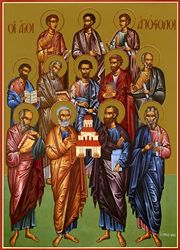Church of the Holy Apostles (Constantinople)

Contents
[hide]History
The original Holy Apostles was dedicated in about 330 by Constantine the Great, who made Constantinople the capital of the Roman Empire. The church was unfinished when Constantine died in 337, and it was brought to completion by his son and successor Constantius II, who buried his father's remains there. The church was dedicated to the Twelve Apostles of Jesus, and it was the Emperor's intention to gather relics of all the Apostles in the church. However, only relics of Saint Andrew, Saint Luke, and Saint Timothy (the latter two apostles of the 70, not the twelve) were acquired, and in later centuries it came to be assumed that the church was dedicated to these three only.
Little is known of the appearance of this church except that it was cross-shaped. The historian Eusebius says that it was a tall building, with porticoes along the four sides, marble walls and a golden roof. In any event, by the reign of the Emperor Justinian I the church was no longer considered grand enough, and a new Church of the Holy Apostles was built on the same site. The historian Procopius attributes the rebuilding to Justinian, while the writer known as Pseudo-Codinus attributes it to the Empress Theodora (wife of Justinian). The second Holy Apostles was consecrated on 28 June 550.
The new church was designed and built by the architects Anthemius of Tralles and Isidorus of Miletus in the form of a Greek cross with five domes: one above each arm of the cross and one above the central bay where the arms intersected. The western arm of the cross extended westward forming the atrium. The relics of Constantine and the three saints were re-installed in the new church, and a mausoleum for Justinian and his family was built at the end of the northern arm.
For more than 700 years the Holy Apostles was the second-most important church in Constantinople, after the basilica of the Holy Wisdom (Hagia Sophia). But whereas the Holy Wisdom was in the oldest part of the city, the Holy Apostles stood in the centre of the newer part of the much-expanded imperial capital, on the great thoroughfare called Mese or Centre Street, and was the busiest church in the city. Most emperors and many patriarchs and bishops were buried in the church and their relics were venerated by the faithful for centuries.
The most treasured possession of the church were the supposed skulls of Saints Andrew, Luke, and Timothy, but the church also held relics of Saint John Chrysostom and other Church Fathers, saints, and martyrs. The church also held what was believed to be part of the "Column of Flagellation," to which Jesus had been bound and flogged. Over the years the church acquired huge amounts of gold, silver, and gems donated by the faithful.
The church was renovated and probably enlarged in the 9th century by the Emperor Basil I. In the 10th century Constantine of Rhodes composed a Description of the building of the Apostles in verse, which he dedicated to Constantine VII Porphyrogenitus. The basilica was looted during the Fourth Crusade in 1204. The historian Nicetas Choniates records that the Crusaders plundered the imperial tombs and robbed them of gold and gems; not even Justinian's tomb was spared. Some of these treasures were carted off to Venice, where they can still be seen in St Mark's Basilica. When Michael VIII Palaeologus recaptured the city from the Crusaders, he erected a statue of the Archangel Michael at the church to commemorate the event, and himself. The church was restored again by Andronicus II Palaeologus in the early 14th century, but thereafter fell into disrepair as the Byzantine Empire declined and Constantinople's population fell. The Florentine Cristoforo Buondelmonti saw the dilapidated church in 1420.
In 1453 Constantinople fell to the Ottoman Turks. The Holy Wisdom was seized and turned into a mosque, and the Sultan Mehmed II ordered the Greek Patriarch Gennadius Scholarius to move to the Holy Apostles, which thus became the centre of the Greek Orthodox Church. But the area around the church was soon settled by Turks, and there was increasing hostility to such a large and centrally located building remaining in Christian hands. Gennadius therefore decided to move the Patriarchate to the Church of St Mary Pammakaristos in the main Christian part of the city, the Phanar district.
Rather than convert the Holy Apostles itself into a mosque, Mehmed decided to demolish it and build a mosque of comparable magnificence on the site. The result was the Fatih Cami (Mosque of the Conqueror), which still occupies the site and houses Mehmed's tomb. There is a limited visual record of the Holy Apostles, but St Mark's Basilica in Venice is partly modelled on it. The 12th century writer Nicholas Mesarites has left a description of the church (see external link), of which only parts survive.
See also
Further reading
- Glanville Downey. "Nikolaos Mesarites: Description of the Church of the Holy Apostles at Constantinople." Transactions of the American Philosophical Society. New Series, Vol. 47, No. 6 (1957), pp. 855-924.
